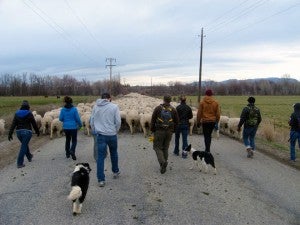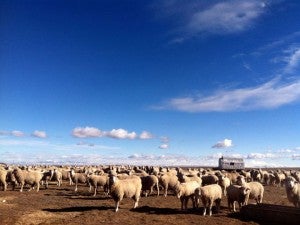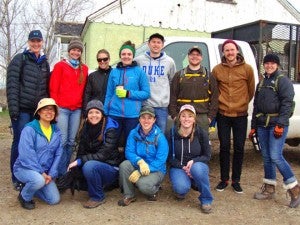Surrounded by more than 2,000 sheep and a few dogs, two men, originally from Peru, alternate between caring for the sheep and tending to their base camp in the foothills and mountains of southwest Idaho. The sheep graze miles from civilization and the men have no form of transportation other than their own feet. If either man were to need urgent medical care, it would take hours for him to get to a hospital or urgent care clinic as the men also have no access to a phone.

Though she is just starting her second year at Boise State, Betzi Quiroz, clinical assistant professor in the School of Nursing, has been working with Peruvian sheepherders in Idaho for more than 20 years. Quiroz emigrated to the U.S. from Peru after her father worked as a sheepherder in Idaho. He became a citizen and moved his family to Boise. Every weekend the Quiroz family would travel throughout Southwest Idaho, sometimes on horseback, to bring homemade food to the sheepherders.
“For the past 22 years, I have seen tremendous changes that have occurred within the sheep industry and especially the many injuries that these herders would suffer at work due to inclement weather, lack of potable water, wildlife, non-existent knowledge of gun use, and their semi-nomadic lifestyles,” said Quiroz. “The number of individuals suffering from diabetes and hypertension has more than doubled in the 22 years I have known them. There is genetic predisposition but their illness worsens at a faster pace due to limited choices for nutritionally-dense foods and almost non-existent medical supervision.”
“As a certified nursing assistant and later as a nursing student at Boise State, I knew that there was something I could do for them so I began teaching basic first aid,” states Quiroz. “With my faculty support, I was able to design a curriculum of first aid for herders. Armed with more information and ability to share that knowledge I have returned year after year to provide these classes and topics that the herders are thirsty for, which could be many, including how to assist women during childbirth at home.”
“As a faculty member, I began to share this cultural immersion opportunity with my nursing students when I began to teach community and public health nursing. I have been able to see the transformation in my students as they learn first-hand how one person can make such a huge difference among a population that is not only vulnerable but also under-served,” said Quiroz.
Quiroz includes her students in her work so that they understand how culture, occupation, and lifestyle impact an individual’s’ health needs and how they can provide culturally sensitive care. Last spring twelve students in Quiroz’s Community and Population Health Nursing Lab, discovered that in the Peruvian sheepherders’ cases, the impact can be huge.

Fourteen sheepherders are employed by Soulen Livestock Co. on a temporary H2A work visa, which is used for jobs which are not filled by US citizens. The sheepherders, ranging in age from 20 to 60, come to Idaho for three years to herd sheep over a 300 mile radius, between the southern Idaho border and the northern mountains of McCall. The sheepherders work 24 hours a day, seven days a week moving their camp every three to four days. Many of them have families back in Peru and they often send the majority of their $750 monthly paycheck back home. They spend the majority of their time outside, exposed to the elements. Weekly or bimonthly, depending on how easily the current camp can be accessed, the foreman brings food and supplies, purchased on a limited budget to serve the two to four bands of sheep, men and dogs.
The students first met with two of the sheepherders in February, on one of the brutally cold days that southwest Idaho experienced this past winter. The students were shocked by what they saw. Over the course of six trips, they drove for miles outside of Kuna, Melba, Letha and Midvale areas, on dirt roads to an extremely isolated camp. The sheepherders were dressed in primarily cotton clothing and were living in a metal wagon, which serves as their shelter for the winter months. As the wind was particularly harsh, the herders had cut open an empty dog food bag and placed it inside the window to the wagon to help keep the wind out of the wagon. The cold was made visible by the ice that consistently formed on the water troughs for the sheep; the herders moved among the water troughs chipping the ice every few hours so that sheep could drink. The herders speak Castilian Spanish and Quechua; very few of them know much English.
During the early visits to three camps, the students conducted health assessments for the herders, which included blood pressure screenings, blood glucose testing, listening to the herders’ heart and lungs, calculating the herders’ Body Mass Index (BMI) and providing education about the early detection of hypertension and diabetes. The students quickly brainstormed some of the herders’ needs and began collecting supplies.
The students compiled extensive first aid kits, with supplies pertinent to the herders’ outdoor life and isolated conditions, and they created a Spanish first-aid resource guide so that the herders would know how to treat common injuries. The students created rice bags, which could be heated in an upside down lid over a pot of boiling water, so that the herders could treat their sore backs, a common complaint, and prevent further back injuries.
The students demonstrated proper hand washing techniques for the herders to prevent disease transmission. The students also provided sunglasses and hats while teaching the herders about how to prevent eye diseases that are common for farm workers. The students also identified a need for gun safety and maintenance education and arranged for an expert to provide lessons to the herders.

While the students gave the herders a lot of supplies and education, the herders gave the students an even greater gift. In their interactions, the students and the herders bonded and the students were invited to join the herders in several traditional Peruvian meals. Quiroz states that this was the first time such an invitation had been extended to students in the eight years she has been working with her students and the herders. The meals served not only as a cultural exchange, but also as an opportunity to discuss nutrition. The students were deeply touched by the sheepherders’ lives and generosity. The students speak of the herders with passion and were pledging to continue to assist migrant workers in Idaho even after their course ended.
The students’ Service-Learning poster, titled “Health Promotion Among Peruvian Sheepherders,” was chosen to be presented at the Civic Engagement Exhibition May 6-9, 2014. Their poster was one of 55 submitted, and was one of ten “Best of Show” posters. Additionally, their poster was selected to be presented at the Bronco Space Symposium on May 6, 2014 for which only three posters out of 35 submissions were selected for the event.
Perhaps most importantly, the students have a new perspective about how to approach their future nursing careers. As student Rebecca Ruby states “it has opened my eyes to the vastness of population and public health. Before it was just a subject in a book, but by working with the sheepherders…, I was able to apply the concepts of every population having unique … health needs. As a future nurse this was an enlightening and gratifying experience to learn … to take into consideration [a patient’s] environment and living conditions as important variables on an individuals’ health status.”
Other students call the experience a “wake-up call” on the plight of migrant workers and how health care providers can advocate for their patients. Quiroz beams with pride as she listens to her students present with vigor and passion on what they learned to a group of nursing students, faculty and staff at the end of the spring term. Quiroz and the students are beginning to form new partnerships with student clubs, such as the Pre-Vet club and the Construction Management Association, who may be able to provide education and assistance for the herders in ways that nursing students cannot.
All the students in the lab agree with their colleague Megan Hull when she says that the experience has been “absolutely transformative.” Hull sums up the semester by saying “the most influential aspect of this experience to me was realizing that regardless of how different our backgrounds are, the languages we understand, and the daily circumstances of our lives, we all share a connection as people… I’ve learned just as much from [the sheepherders] as they may have from all of us.”
[slider id=”P-Sheepherders-Health-2014″][/slider]